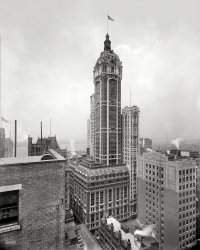
MAY CONTAIN NUTS

Search Shorpy
SHORPY ART

Framed or unframed, desk size to sofa size, printed by us in Arizona and Alabama since 2007. Explore now.
Join and Share
Ad-Free Shorpy
Shorpy is funded by you. Patreon contributors get an ad-free experience.
Learn more.

Recent comments
- +112
- Rear View
- Way in the back --
- Button It Up
- And with an eye on the time ...
- Working in an enclosed ashtray
- Rear View Mirror?
- Tobacco cam
- Basic fact I learned only later in life
- Put a Lid on it!
- Pinstripes in the Tower
- Sound enhancement
- 3438 in '38
- Second Career
- Their days are numbered
- Only the Sensor
- Train control mechanism
- Rarest of the Rare?? & Classy 3400 Class
- Control Mechanism
- Those standpipes
- Wrenches
- International D-40 I believe
- Job prospects
- You had me at Train
- Land of the free
- Broad-Exchange Bldg
- Parking innovation
- The old block
- "Peck turned a sweet propeller"
- National Bank Building
Member Photos
The Shorpy
Printporium
Printporium
Search Shorpy
Search results -- 30 results per page
- Ladies Who Lance: 1930
- ... garden of the Mayflower Hotel. Entries closed Thursday night and the following were named to compete for the individual championship ... Posted by Dave - 04/26/2013 - 4:36pm -
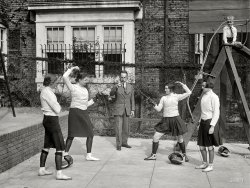
- The White Menace: 1939
- ... today showed us a view of these same steps during the night of Feb 5/6, 2010, with go carts and snowmobiles driving up the almost ... Posted by Dave - 07/17/2012 - 10:29pm -
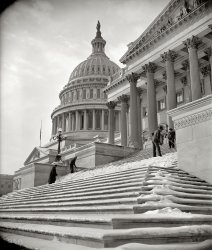
- Gone Visiting: 1939
- ... are so numerous that it's almost impossible to drive at night during the rutting season. I don't want to start a political argument, ... Posted by Dave - 08/09/2012 - 12:35pm -
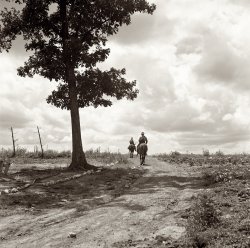
- Raised on Radio: 1942
- ... My brother and I listened to our favorite programs every night after supper. And the screen was limited only by the size of our own ... Posted by Dave - 02/09/2018 - 11:08am -
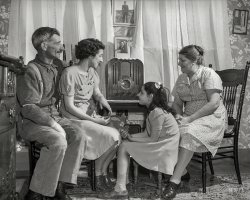
- Engauged: 1942
- ... furnace. No more shovelling, or banking the fire for the night.
[They did during the war. - Dave]
Oil to coal furnace ... Posted by Dave - 01/09/2014 - 5:59pm -
![Engauged: 1942 September 1942. "Washington, D.C. Conversion of the Shoreham Hotel furnace from oil to coal burning system." Crank it, boys, and let's see what this thing'll do. Photo by Howard Liberman for the Office of War Information. View full size.
WartimeOil to coal would seem to be a step back in terms of efficiency. Was this a wartime requirement?
I say Tomato ... what do you say?Dave, quite apart from the picture itself, I was somewhat intrigued by your choice of title, "Engauged." On this side of the pond, a gauge is a gauge. In almost all U.S. usage,I have seen it spelled as "gage." Yet you used "gauge." When is a gauge a gage, (other than a greengage)?
[Standard spelling for the word in America is "gauge." The use of "gage" as a variant spelling (at least among people with college educations) is much less prevalent, probably about equal in popularity with the misspelled variant "guage." - Dave]
Nobody went back to coal from oilMy dad was thrilled to get an oil furnace. No more shovelling, or banking the fire for the night.
[They did during the war. - Dave]
Oil to coal furnaceFrom The Harvard Crimson October 29, 1942:
"In order to save the precious war fuel the University is undertaking a mass conversion from oil furnaces to coal consuming burners. Although the change is not yet complete practically all of the heating units will be made over by November 1.
When the change is made, Harvard will be saving oil at a rate of 87,000 barrels (3,654,000 gallons) a year for the war effort."
Also, this ad from the September 20, 1942 Brooklyn Eagle:
Cellar CockpitAdd a turn and bank indicator and you have the instrument panel of the "Spirit of St. Louis."
GaugesBack then, gauges didn't need units on the faces! That was for sissies! Everybody just knew what they meant.
(Technology, The Gallery, D.C., Howard Liberman)](https://www.shorpy.com/files/images/SHORPY_8d36801u.thumbnail.jpg)
- Disneyland: The Dark Side (1963)
- ... Restaurant), Skull Rock was particularly creepy-cool at night, when I took this time-exposure Ektachrome in 1963. Alas, the ship, ... Posted by tterrace - 10/30/2011 - 2:14pm -
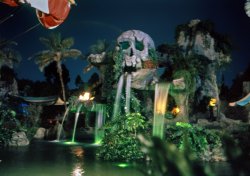
- Now Highering: 1912
- ... Fire Alarm Box. This lamp will have a red glass shade. At night, one could immediately locate the nearest fire alarm box by looking for a ... Posted by Dave - 10/16/2019 - 8:44pm -
![Now Highering: 1912 New York circa 1912. "Broadway, looking north from Cortlandt Street and Maiden Lane." Our second look in recent weeks at the Woolworth Building in the final stages of construction. 8x10 inch dry plate glass negative. View full size.
Mourning jewelry window signAs anyone who every watched "Antiques Roadshow" or has done any research into old jewelry knows, it used to be a common practice to mourn one's dear departed with "remembrance" jewelry to keep in mind the loved ones who are no longer with us. Some people were in mourning for years and others, like Queen Victoria, mourned her late husband Albert for the remainder of her long life. Lots of this jewelry has black stones or black metal and some of it even incorporated locks of hair of the deceased. Some of it was exquisite and very expensive and is in museums it is so valuable, and some not so much. I had never seen it advertised in other Shorpy pictures though, so this is a first for me.
"The Tubes"Pole sign, "Hudson Tunnels" - The Hudson and Manhattan Railway Tunnels - Known locally as "The Tubes"; service began between Lower Manhattan and Jersey City, July 19, 1909. Known today as the PATH System by the younger folk, but still the Tubes to me.
What, pray tell... is that statute on top of one of the buildings.
[Appropriately enough, it's atop the Walkover Building. -tterrace]
Cable railwayMany people will know of the cable cars of San Francisco, this picture shows a similar system in New York. The Broadway cable railway opened in 1893 and ran Battery Place from Whitehall Street to Broadway - Broadway to Seventh Avenue - Seventh Avenue to 59th Street.
The motive power was provided by a continuous steel cable running in a slot under the street between the rails. The central powerhouse was at Houston and Broadway.
[Those slots are for access to underground electrical conduits. The last of Manhattan's cable-powered lines had been converted to electricity by 1901. -tterrace]
street lightWhat is the smaller light (?) just behind the street light across Maiden Lane?
Conduit CleaningThe rectangular panels located between the streetcars' running rails and the centered slot rails were to allow access to the electrical conduit whenever necessary to clear the conduits accumulation of the abundant brown debris seen on the surface of the street.
PurportedlyWoolworth could see the completed building from his summer home, Winfield Hall, in Glen Cove on the North Shore of Long Island.
Just for comparison, The Woolworth Building started construction in 1910, and Winfield Hall was rebuilt (after a rather suspect fire) in 1916; the skyscraper cost an estimated $13.5M to build, while the rebuilt Winfield Hall racked up an impressive price-tag in excess of $11M -- including a $2M marble staircase.
Fire Alarm Box LightIn response to the post by Jmarksr: The smaller light beyond the streetlight marks the location of a Fire Alarm Box. This lamp will have a red glass shade. At night, one could immediately locate the nearest fire alarm box by looking for a red lamp.
In my youth, the globes in some towns & cities were red, and in others the globes were orange. I don't know why.
(Some towns also had green lamps on police call boxes.)
The early fire alarm boxes were "Telegraph" boxes which used an ultra-reliable spring-wound clockwork mechanism to tap out the code of the fire box on a dedicated telegraph line to the Fire Dept., where it was recorded as punch marks on a moving paper tape. (Later, some cities converted to an actual telephone system.)
The telegraph system was powered from lead-acid batteries at the Fire Dept. It would function even during a power failure, as the batteries could support the system for many days.
(The Gallery, DPC, NYC, Streetcars)](https://www.shorpy.com/files/images/SHORPY-4a25583a.thumbnail.jpg)
- Modern Motorist: 1908
- ... Jackson can be seen in the movie Long Day's Journey Into Night (1962).
(The Gallery, Cars, Trucks, Buses, Harris + Ewing) ... Posted by Dave - 01/19/2013 - 6:16pm -
![Modern Motorist: 1908 Washington, D.C., or vicinity circa 1908. "Mrs. John E. Harris." At the wheel of a shiny new Jackson. Harris & Ewing Collection glass negative. View full size.
Well not *too* shinyA fair bit of mud on the inside of the fender, though I suppose it was unavoidable given the roads of the time. By the way, I suspect that Mrs. Harris wasn't actually driving the car, but just posing for the photographer. None of her clothes are being buffeted by the wind and her posture seems rather contrived.
I thought she looked familiar....
Patched Tire?Maybe not so new considering the condition of the tires. Great pic though.
Count 'emEach tire/wheel has four "stems" projecting inward. One looks like a standard stem for filling the tire with air. The other three are different from the first, but they look alike. Any idea what they were used for?
[They're rim clamps. -Dave]
Re: Count 'emThere are five "stem-like" projections on each wheel. One of them (e.g., the one at about 1:00 on the right front wheel) is the air valve stem. The four that are spaced at 90 degrees around the wheel are "staybolts" (or "lugs") that held the tire in the rim. A couple of years after this picture, Firestone introduced the "detachable rim" that obsoleted the staybolt system.
Searching for "tire staybolt" should find a Google book with some illustrations that sort of show how they worked.
Jackson and the Indianapolis 300The Jackson Car was made in Jackson, Michigan from 1903 - 1923. This appears to be a circa 1908 Model C with a handmade leather Maryland license plate.
The next year a standard Jackson car was leading the 300 mile long Wheeler-Schebler Trophy Race at the Indianapolis Motor Speedway (not yet paved with brick) by more than 10 miles when the race was called off because of poor track conditions and a deadly crash.
No winner of the race was declared, but Jackson announced their win in at least one ad and showed a picture of the trophy in the ad. They had covered 235 miles (94 laps).
Since Jackson was not declared the winner they sued for the trophy, but the company lost in court. It was not until many years later they they were acknowledged as the winner of the race.
Only six cars out of 19 were still running when the race was called. One of those six drivers was Roy Harroun who would later go on to win the first Indianapolis 500 in 1911. He was also the first person to be presented the Warner-Schebler trophy when he won a 200 mile race at the Speedway the next year.
The 7 foot tall trophy was made by Tiffany and valued at $8,000 by its donors. The trophy was only the property of the winning company/driver for a year. When Harry Hartz won the trophy three years in a row, per the deed of gift for trophy, it was permanently awarded to him. He donated it to the Indianapolis Motor Speedway Museum when it opened in 1956. It is still on exhibit there today.
A circa 1908 Jackson can be seen in the movie Long Day's Journey Into Night (1962).
(The Gallery, Cars, Trucks, Buses, Harris + Ewing)](https://www.shorpy.com/files/images/SHORPY_15015a.thumbnail.jpg)
- Detroit tourism, 1930s
- ... architect Frank E. Kirby, they were built to provide "night boat" overnight service, transporting up to 1,500 passengers between ... Posted by bhappel - 09/28/2009 - 11:09am -
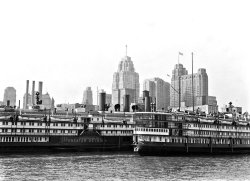
- Hipsters: 1969
- Ready for a night out (can't remember where), Barb and I (Dave) sport the latest in 1969 ... in your shoe? If you were in Atascadero in 1969, your night out was at the feed store.
Like it! Definitely a bit of a Beatle ... Posted by Westcoaster - 05/07/2010 - 7:36am -

- Do Not Disturb: 1939
- ... with his father from Houston to Edinburg, Texas." Good night, John-Boy. Medium-format nitrate negative by Russell Lee for the ... Posted by Dave - 01/15/2013 - 2:12pm -
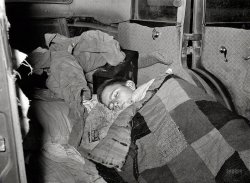
- Mom and M1: An Khe, 1969
- ... stationed in An Khe Feb 1969 - May 1969. I remember one night when the VC were inside the perimeter and tossing "satchel charges" in ... Posted by BorisDaBastid - 11/01/2009 - 2:14pm -

- War Work: 1943
- ... because there was a war on. There were plenty of small night clubs and dance joints, though…my mom remembers lots of dances and card ... Posted by Dave - 05/04/2016 - 1:27pm -
![War Work: 1943 May 1943. Arlington, Va. "Idaho Hall, Arlington Farms, a residence for women working in government for the duration of the war." Medium format nitrate negative by Esther Bubley for the Office of War Information. View full size.
perfect picture for Mothers Day!That could have been my mom, too….except she came to Washington from North Dakota, worked at the Interior Department for the Grazing Service (now the BLM), and lived in a boarding house on R Street NW. She made Washington sound like the hub of the universe at that time, full of bright young people who came from all over the country to help out (and get decent jobs) with all the new agencies set up to end the Depression, and later, to step in when the men got sent off to war. My mom got sent out west to do payroll for the Grazing Service in Pocatello and Salt Lake City, making sure forest-fire fighters got paid; she ran into a lot of what she used to call 'guff' from the Western roughnecks because only men had ever had that job before. She said Salt Lake City was so dirty, she had to have 2 work dresses to alternate because she could only wear a dress once in the filthy air before it needed washing. During the war, office workers in Washington regularly worked overtime during the week, and worked on Saturdays for free, because there was a war on. There were plenty of small night clubs and dance joints, though…my mom remembers lots of dances and card parties at the boarding house too. Then she met my dad (who was 4-F) and that's how I came to be typing up this comment!
Reminds Me of my MotherMy mother was from Ohio but moved to Washington, D.C. during the war to work at the Civil Aeronautics Administration, the forerunner of the FAA. In fact she met my father, who was at Walter Reed Hospital recovering from war injuries, in 1943. This lady is not my mother but she does resemble her with the glasses. Don't know where my mother lived in D.C. during this time period.
Dumbo and his magic featherNice photo! My eye was immediately drawn to the cute sketch of Dumbo on the wall- because I love elephants! Disney's film Dumbo came out in 1941 and I believe it was quite popular. My children loved watching it over and over- I can probably still sing all the songs! In the movie, Timothy Mouse gave Dumbo a feather when he was up in the tree, saying it was "magic" so Dumbo wouldn't be afraid to fly-and he found he could fly! Later in the circus act, he loses the feather, but finds out he can fly without it!
The RingI am curious about that ring on her finger and the "Book" she is reading. The ring looks like a class ring, and the book looks like a hard back Bible.
[Only if Bibles have SHAKESPEARE on the back cover. - Dave]
Thanks Dave. Eyesight not what it used to be, even up close :>) [BAXADO]
Ok, thanks for the update on the ring.
Re: ring It's hard to be sure, but it looks like a Phi Gamma Delta fraternity ring, presumably from a fiancé.
(The Gallery, D.C., Esther Bubley, WW2)](https://www.shorpy.com/files/images/SHORPY-8d29771u.thumbnail.jpg)
- Anytown, USA: 1941
- ... -- it's dinnertime. Boys!!
Radial Wave Shade By night this house would have been illuminated by a clear incandescent light ... Posted by Dave - 03/20/2020 - 5:07pm -
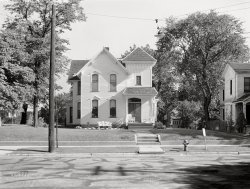
- A Double Shot: 1909
- ... buy me out so I kin go home.' He sells every afternoon and night. Extra late Saturday. At it again at 6 A.M. Sunday." Photo by Lewis ... Posted by Dave - 03/21/2019 - 12:27pm -
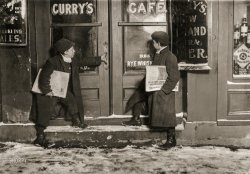
- Personal Transportation: 1921
- ... minor differences (hers did not come with the canopy nor night travel options) but the suspension, chassis and such are identical. Nor ... Posted by Dave - 08/24/2012 - 8:49pm -
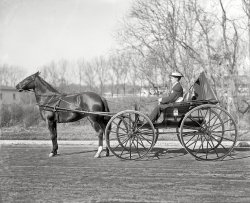
- Dark or Light?
- ... mother however perpetuated the tradition of St. Nicholas night, Dec. 12, where we were to leave a small plate on the floor by our bed to ... Posted by Dave - 09/08/2011 - 9:09pm -
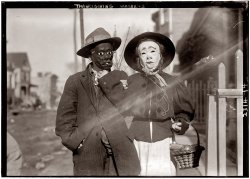
- Bird Balls: 1957
- ... In the case of these birds, they are kept awake half the night with all the traffic, and have nowhere to go and nothing to do in those ... Posted by Dave - 02/22/2013 - 3:48pm -
![Bird Balls: 1957 August 13, 1957. "Tamarack Lodge, Greenfield Park, New York. Lobby to cages." Another defunct Catskills resort. Gottscho-Schleisner photo. View full size.
Bird brain...ed arsonist charged, and lots of other Tamarack links here.
A strange and unhappy endAfter years of abandonment, it looked like the old Tamarack Lodge would get a new lease on life after an investor bought the property with the intent of renovating it. Last summer, according to police, the investor started to burn some debris near the property, the fire ended up going out of control, and you can figure out the rest of the story.
[Gosh. I hope he had millions of dollars' worth of insurance. Purchased shortly before the fire. - Dave]
Looking backHere they are again, this time taken from the opposite side of the room.
Glad those days are gone.We know now that it extremely cruel to decorate a business with live animals. In the case of these birds, they are kept awake half the night with all the traffic, and have nowhere to go and nothing to do in those horribly small cages. Another thing we learned 20 years ago is that you never keep parrots in round cages. That's why you rarely see them anymore.
Real or stuffed?Were those birds real?
If so, those cages strike me as cruel (way too small for those birds), and impractical to boot. Well, the greens below might have made good use of the guano. But imagine having to clean the lower half of those cages. Yuck!
Avian exoticaShowy birds were the thing of the era. The Fauncy Destination restaurant near our house when I was a little kid was a place called the Peter Pan, which was among other things famed for the peacocks which roamed the grounds. On the other hand, you don't even need to smell the formaldehyde and vinyl chloride to know that all those plants are of the finest plastic.
[Some of these may be real; Tamarack Lodge had its own greenhouse. - Dave]
Maybe so, but those Strelitzia flowers aren't: I have one myself, and the leaves alone are a foot long and stand two feet above the pot. Even a philodendron would be hard pressed to grow in that cavern.
(The Gallery, Gottscho-Schleisner)](https://www.shorpy.com/files/images/SHORPY_5a25319u.thumbnail.jpg)
- Snappy Lunch: 1940
- ... looks as though it had more than its share of Saturday night bar fights.
Nothing exceptional Just regular meals.
What, you ... Posted by Dave - 08/15/2018 - 1:38pm -
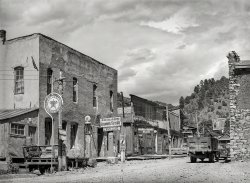
- Good Eats: 1937
- ... his wife sitting at home waiting for him to return from a night of drinking with buddies. It's called "The Peacemaker."
312 Conti ... Posted by Dave - 07/26/2014 - 12:41pm -
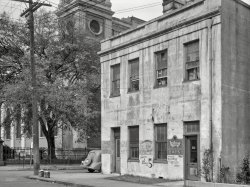
- Light Cleaning: 1943
- ... used to prevent a wayward Japanese eye from seeing it at night!
Also, this guy was an "electrician" on a steam engine, besides the ... Posted by Dave - 12/18/2012 - 3:12pm -
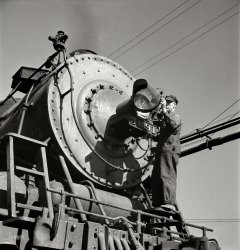
- Double Bill: 1926
- ... letting the world know about it. She opened last Thursday night in a new play on Broadway, “It's a Wow,” in which cast also ... Posted by Dave - 12/03/2013 - 9:41am -
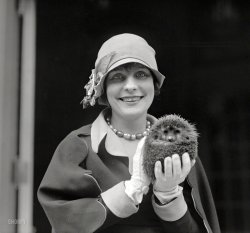
- Las Vegas Club: 1951
- ... On a road trip in 1977 I stopped in Las Vegas for one night. I don't gamble, but the neon signs were spectacular and the people ... Posted by Dave - 08/01/2021 - 5:49pm -
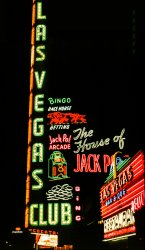
- Left Hanging: 1939
- ... hang some wash out on the line."
"At ten o'clock at night??"
Virgil Ignoble labor produces a purification of the ... Posted by Dave - 10/03/2018 - 1:16pm -
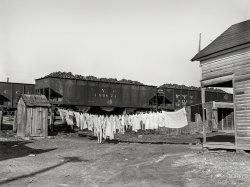
- Halloween Hobo: 1957
- ... the type of stuff we would assemble to wear on Halloween night, mostly from the castoffs of our dads and grandfathers (which doesn't say ... Posted by Dave - 10/30/2013 - 12:21pm -
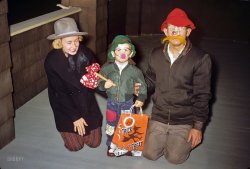
- Maison Blanche: 1910
- ... know any more about this? Are there any shots of it at night? If so (and if I'm right) - it must have been the wonder of the day!
... Posted by Dave - 07/19/2012 - 1:01pm -
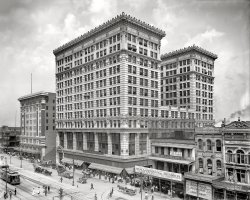
- Meats and Groceries: 1905
- ...
The visit was usually reserved until the last full night and I can still remember the flounder I had my first trip.
The Steel ... Posted by Dave - 08/24/2011 - 1:24pm -
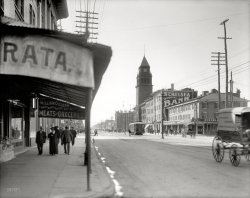
- I Can See Right Through You: 1936
- ... "Me and Cindy Lou went parking at passion point last night, and everything was going great, and all of a sudden she says I'm a ... Posted by Ken - 09/07/2011 - 10:08pm -
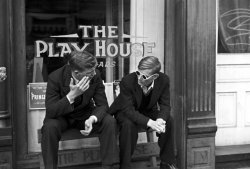
- Rural Pacification: 1941
- ... the pacifiers. Ha! Next thought, does Dave lay awake at night thinking up these witty wisdoms or do they just come naturally? In ... Posted by Dave - 10/04/2018 - 12:28am -
![Rural Pacification: 1941 May 1941. "Farm worker with his wife and their twin babies at the FSA migratory labor camp mobile unit. Wilder, Idaho." Medium format acetate negative by Russell Lee for the Farm Security Administration. View full size.
Semi digitalBoy they look young, with a very nice hand-me-down pram. Looks like our young mother is missing a digit. Farming accident?
[You are mistaken (see below). Fingers bend! - Dave]
Gave me a chuckleSeeing Dave's comment "pacification" I couldn't see the connection of parents and a baby carriage to pacification, then I saw the pacifiers. Ha! Next thought, does Dave lay awake at night thinking up these witty wisdoms or do they just come naturally? In either case, thanks for the extra enjoyment.
[Rural Pacification comes from the Vietnam War. - Dave]
The happy familyDad seems a little overwhelmed, or maybe unsure about being photographed, but Momma's expression of pride and love is unmistakable. I hope they prospered.
Maybe later, Dad will get to enjoy a Grain Belt beer.
That SmirkThe smirk on Mom's face and her hand nudging the squinting twin into facing the camera make me laugh. Parents never change and neither do babies!
Side BuckleThe way the fella is wearing his belt is interesting. You'd see more of that style of wearing the belt with the greasers/rockabilly guys in a few years from when this photo taken.
[Actually the side buckle was a staple of 1930s men's fashion. - Dave]
The wearing of the buckleI wore my belt buckle off to one side in the '60s. I didn't want to scratch the paint on the fender of my car when working on it, which was a constant thing.
(The Gallery, Agriculture, Kids, Russell Lee)](https://www.shorpy.com/files/images/SHORPY-8c01289a.thumbnail.jpg)
- New York Giant: 1908
- ... the point of absurdity. You *worked* in the area, and at night it was a ghost town. Things most definitely have changed.
Happy Meal ... Posted by Dave - 08/06/2013 - 10:03am -
